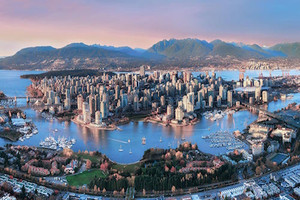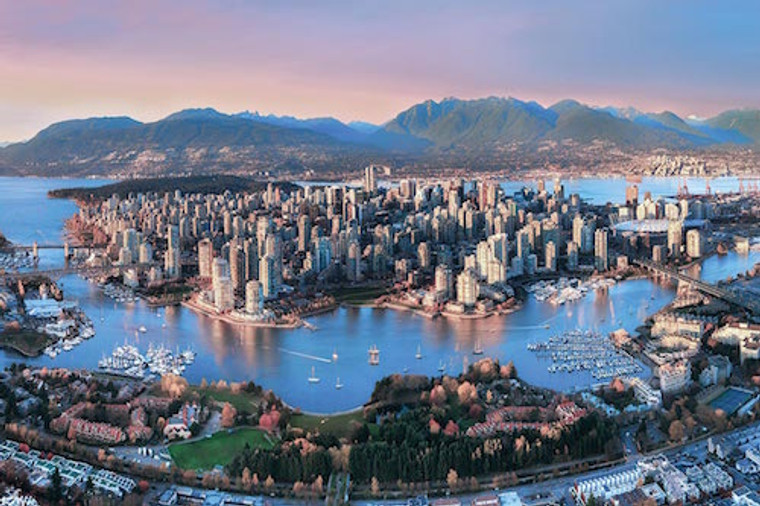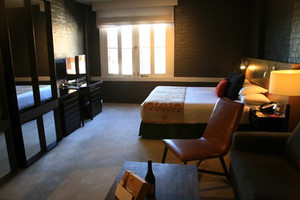
A typical start to the day in Vancouver: you grab a takeaway coffee and head to Stanley Park for a bit of exercise and people-watch the joggers, rollerbladers and dog walkers. Flocks of Canadian geese share the skies with the seaplanes that constantly buzz in and out of the harbour over the snowcapped mountains that rise almost a kilometre up from near the edge of the water.
The sun breaks through the clouds and catches the downtown skyscrapers, and the glass and steel cityscape transforms into a functional piece of modern art. Vancouverites respond to the sun and it’s smiles and nods all along the Stanley Park seawall and why not? The clouds are burning off, and there’s a full day ahead to enjoy all that Vancouver has to offer.
Vancouver's Appeal
Canada’s biggest west coast city, situated just over the US border, is a dangerous place - that’s not to say you’re going to get mugged, but its danger lies in the fact that it’s a hard place to leave. Most locals have stories of friends who came for a visit and then never returned to where they were from. Vancouver has been widely described as the most scenic city in North America, and while San Francisco may have a problem with that, few others would argue with that description.
Set on a magnificent harbour ringed by a wall of mountains, the city’s densely packed skyscrapers compete for the blue sky, adding a touch of the modern to an already dramatic landscape. The smell of salt air mingles with the uplifting aroma of the surrounding forests and Vancouver’s natural beauty really gives it its northwest Pacific frontier feel. But down at street level there’s a level of sophistication, without the pretentiousness of other international cities.
Stanley Park
Getting out and about in Vancouver is made easy by the grid system of the compact downtown, and the fact that most of the must-do sightseeing and experiences are walkable, or easily reached by ferry or bus. Stanley Park is an oasis of green attached to the northern end of the city, and at 1000 acres it’s bigger than New York’s Central Park. It’s surrounded by water on three sides and an eight kilometre seawall circumnavigates the park which is the city’s most popular biking, blading, jogging and walking track.
Trails also criss-cross through the interior of the park with its 50metre cedar, fir and pine, but out on the seawall every sweep and turn reveals another fantastic vista. From Vancouver Rowing Club on the southern end, it’s the downtown skyline and the Convention and Exhibition Centre; from Brockton Point in the east, it’s North Vancouver with its houses built into the mountain range and the seaplanes; from Prospect Point in the north it’s the impressive Lions Gate Bridge.
Further around to the western side of Stanley Park, the unusual Siwash Rock stands as a symbol of individuality and independence - it’s a symmetrical column of stone that looks man-made and the First Nations people believe it has special powers. Some pretty beaches are also on the western side and a good place to be rewarded with a cool drink is at English Bay Beach - this is right on the western end of the downtown and is a happening local place especially on warm weekends.
Granville Island
No trip to Vancouver would be complete without a ride on one of the city’s aquabuses - or mini-ferries - which cruise around False Creek to the south. It’s relatively inexpensive, as well as a great way to see the south and east side of the city and catch a bit of riverlife as well. The aquabuses are also the best way to get to Granville Island (a peninsula under the Granville Bridge) which is home to Vancouver’s biggest market selling all manner of fresh foodstuffs and flowers. In days gone by, Granville Island was a bustling industrial centre with saw milling, ironwork, slaughterhouses and other manufacturing plants and the area became largely deserted in the 1960’s.
The transformation began in the 1970’s and now Granville Island is an intriguing and eclectic mix of markets, restaurants, bars and cafes, art schools and a recreation centre which features kayaking and sailing. Its industrial past hasn’t been bulldozed away either - much of the reconstruction and reclamation retained the corrugated iron walls and industrial doorways along with the back alleys and the old rail tracks. Granville Island is one of those places that can be covered in a couple of hours, or a couple of days - but either way, most people end up sitting at a waterfront bar or cafe to finish off the experience.
Downtown
Stopping for coffee is something of a ritual for Vancouverites and you’ll rarely have to walk for more than a block for a shot of caffeine - on Robson Street in Downtown there there used to be two Starbucks directly across the road from each other barely 20 metres apart, and both were always busy. Singer Bette Midler captured Vancouver’s cafe culture eloquently at a performance in the city: "I've never seen so much coffee in all my life. The whole town is on a caffeine jag, and still nothing gets done any faster."
Back in the city proper and several mini-districts in Downtown have developed their own individuality and reputations - Yaletown in the south-east underwent a major facelift more than a decade ago, like Granville Island. A former rundown textile district, it was transformed into a trendy neighbourhood with renovated warehouses and hip bars and nightclubs. On Mainland and Hamilton, designer boutiques for clothes and interior design have sprung up.
Meanwhile Historic Gastown, north east of Downtown, marks the start of modern day Vancouver and was the site of the founding of the city in 1870. It’s also home to the famous Steam Clock on the corner of Water and Cambie - it’s one of the most photographed landmarks in Vancouver and it actually emits steam and toots on the hour. Exactly why this happens is a bit of a mystery, given that the area was actually named after Captain John “Gassy Jack” Deighton (so named as he loved the sound of his own voice) who built a saloon in the area within 24 hours to mark the start of European settlement in Vancouver.
Further to the east of Gastown is Chinatown - the third largest in North America - it has the hustle and bustle you’d expect. Lively market stalls operate next to busy restaurants, herb and medicine stores, live animals and textiles. Robson Street which runs through the heart of Downtown is a shoppers’ paradise with almost every retail store imaginable .
Grouse Mountain
A little bit further afield on the north side of the city, the Capilano Suspension Bridge is another way to get close to nature - with a bit of thrill seeking involved. It’s a “swervey” 137 metre bridge with a 70 metre drop to a rocky canyon floor - if you can keep your presence of mind it’s a great way to experience the magnificent rainforest on the north side of the city. And further up the road is one of Vancouver’s “hidden” gems. Grouse Mountain is a ski resort that operates 12 months a year - out of snow season it offers panoramic views of Vancouver from 1250 metres. The eight minute tram ride to the peak is invigorating in itself, and at the top there are hiking trails and an endangered wildlife sanctuary which features orphaned grizzly bears which were rescued when they were cubs.
With stunning views over Vancouver, Altitudes Bistro is the ultimate sunset venue in this part of the world - the sun drops over the ocean and an orange hue filters through the city and Stanley Park. The sunset is quickly replaced by night, and the city shimmers in the distance like a jewel in the Pacific.
- By:
- Ben Hall














